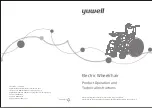
Invacare® TDX® SP2 Series
6.7 Use on public roads
If you wish to use your mobility device on public roads and
lighting is required by national legislation, then your mobility
device needs to be fitted with an appropriate lighting system.
Contact your Invacare provider if you have any questions.
6.8 Pushing the mobility device in freewheel
mode
The motors of the mobility device are equipped with
automatic brakes, preventing that the mobility device starts
rolling out of control when the remote is switched off. When
pushing the mobility device manually whilst freewheeling,
the magnetic brakes must be disengaged.
Pushing the mobility device by hand may require
more physical force than expected (more than 100
N). The necessary force nevertheless complies with
the requirements of ISO 7176-14.
The intended use of the freewheel mode is to
maneuver the mobility device over short distances.
The push handles or push bars support this function,
but be aware that there might be some impairment
between the feet of the assistant and the rear part
of the mobility device.
6.8.1 Disengaging motors
CAUTION!
Risk of the mobility device running away
– When the motors are disengaged (for
push operation whilst freewheeling), the
electromagnetic motor brakes are deactivated.
When the mobility device is parked, the levers
for engaging and disengaging the motors
must without fail be locked firmly into the
"DRIVE" position (electromagnetic motor brakes
activated).
The motors may only be disengaged by an attendant,
not by the user.
This ensures that the motors are only disengaged
if an attendant is available to secure the mobility
device and prevent unintended rolling.
The lever for disengaging the motors is located behind the
motors.
86
1578997-E
















































